Organizational Behavior Essay: Analyzing Motivation Research
VerifiedAdded on 2020/03/23
|8
|2022
|233
Essay
AI Summary
This essay critically analyzes research by Guclu and Guney (2017) on the impact of motivational techniques used by managers to enhance worker productivity, examining the relationship between motivation, job satisfaction, leadership styles, and performance. It explores the significance of the research question, data collection methods, and key findings, including the influence of demographic factors on employee perceptions of motivation tools. The essay compares the research with various theoretical perspectives, such as Maslow's hierarchy of needs, and other relevant studies on leadership styles and motivation. It highlights the strengths of the study, such as the consideration of baseline data, while also pointing out weaknesses related to research design, sampling techniques, and the lack of focus on personality traits. The essay recommends improvements to the research, such as using different questionnaires for managers and employees and incorporating personality assessments to enhance data validity and transferability. Ultimately, the essay aims to provide a comprehensive overview of motivation techniques in the workplace and offer insights for future research.
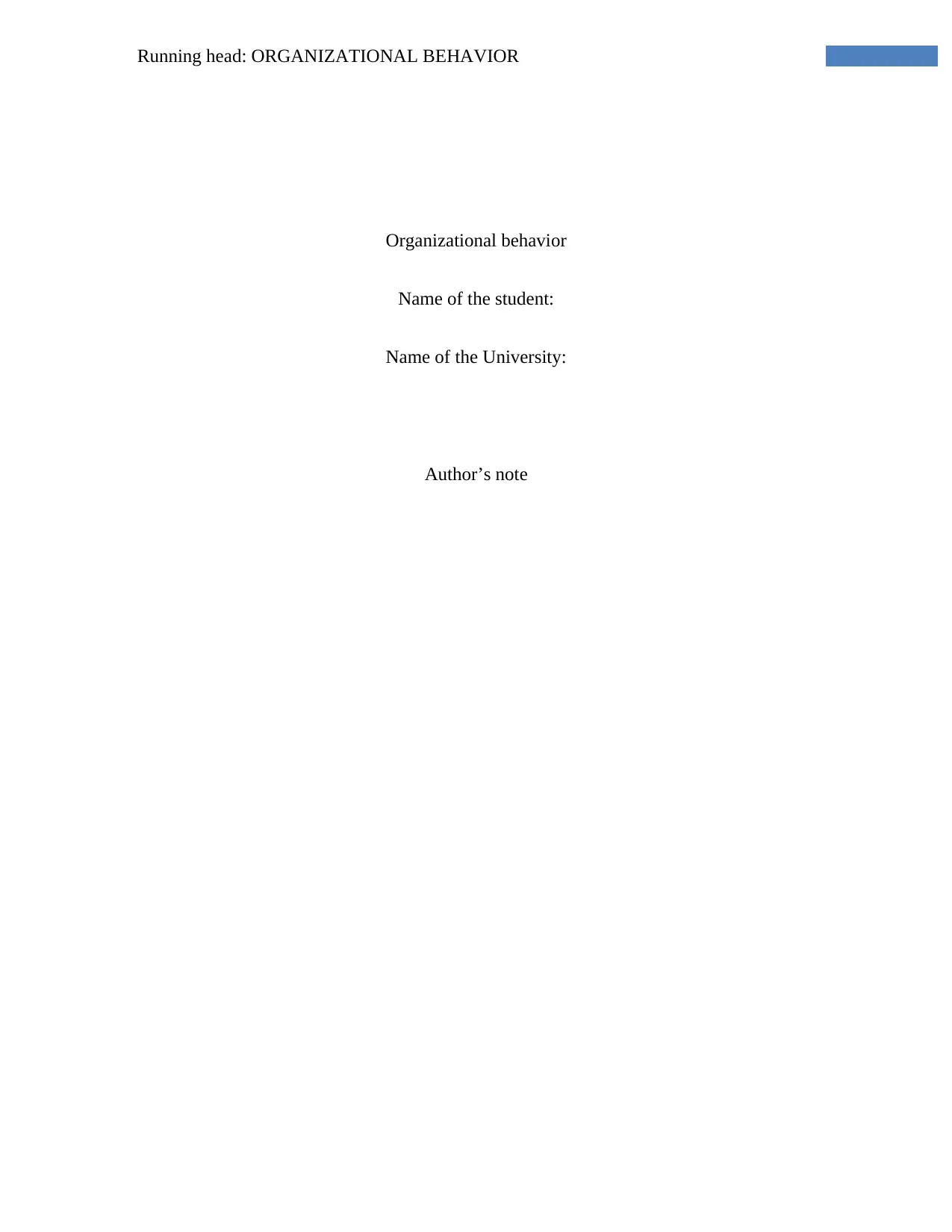
Running head: ORGANIZATIONAL BEHAVIOR
Organizational behavior
Name of the student:
Name of the University:
Author’s note
Organizational behavior
Name of the student:
Name of the University:
Author’s note
Paraphrase This Document
Need a fresh take? Get an instant paraphrase of this document with our AI Paraphraser
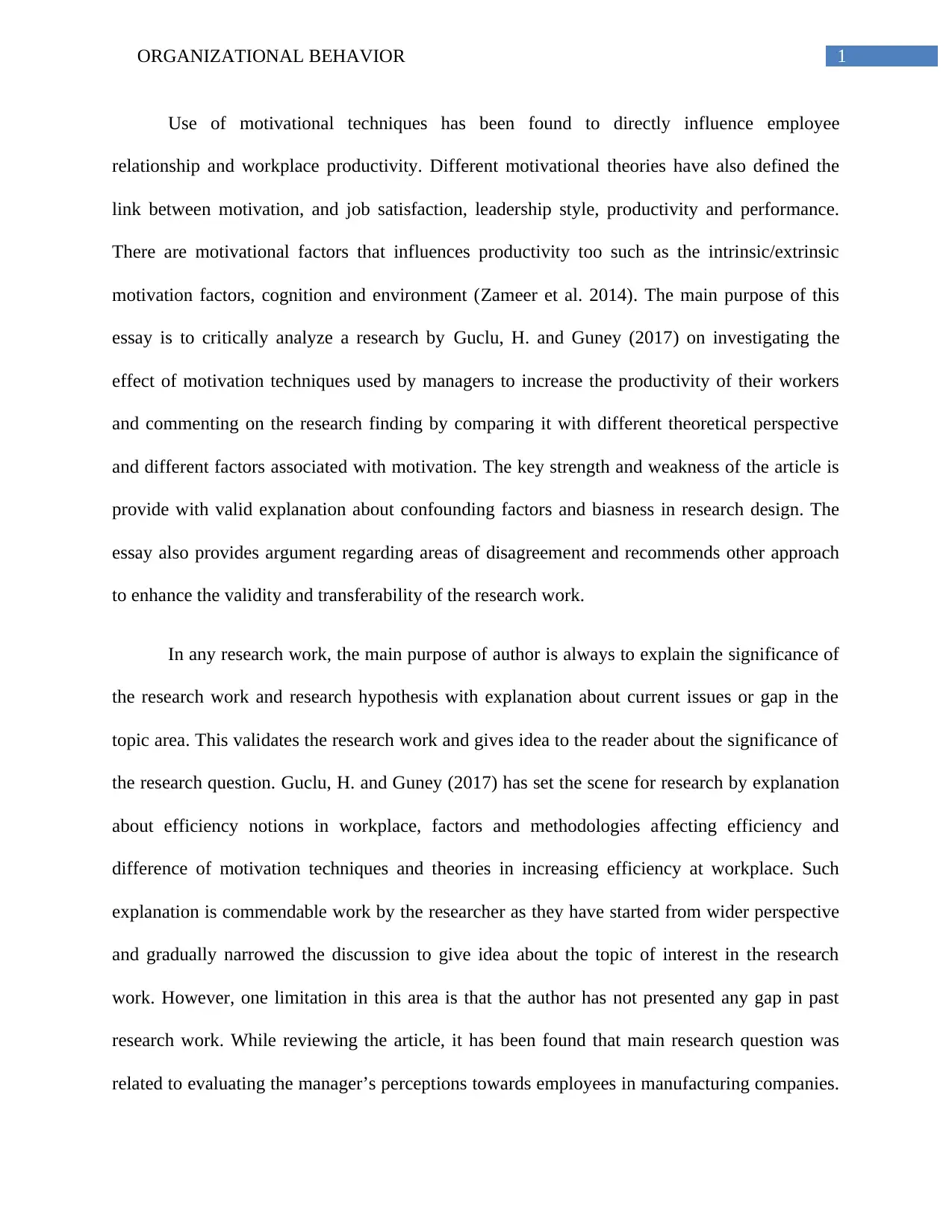
1ORGANIZATIONAL BEHAVIOR
Use of motivational techniques has been found to directly influence employee
relationship and workplace productivity. Different motivational theories have also defined the
link between motivation, and job satisfaction, leadership style, productivity and performance.
There are motivational factors that influences productivity too such as the intrinsic/extrinsic
motivation factors, cognition and environment (Zameer et al. 2014). The main purpose of this
essay is to critically analyze a research by Guclu, H. and Guney (2017) on investigating the
effect of motivation techniques used by managers to increase the productivity of their workers
and commenting on the research finding by comparing it with different theoretical perspective
and different factors associated with motivation. The key strength and weakness of the article is
provide with valid explanation about confounding factors and biasness in research design. The
essay also provides argument regarding areas of disagreement and recommends other approach
to enhance the validity and transferability of the research work.
In any research work, the main purpose of author is always to explain the significance of
the research work and research hypothesis with explanation about current issues or gap in the
topic area. This validates the research work and gives idea to the reader about the significance of
the research question. Guclu, H. and Guney (2017) has set the scene for research by explanation
about efficiency notions in workplace, factors and methodologies affecting efficiency and
difference of motivation techniques and theories in increasing efficiency at workplace. Such
explanation is commendable work by the researcher as they have started from wider perspective
and gradually narrowed the discussion to give idea about the topic of interest in the research
work. However, one limitation in this area is that the author has not presented any gap in past
research work. While reviewing the article, it has been found that main research question was
related to evaluating the manager’s perceptions towards employees in manufacturing companies.
Use of motivational techniques has been found to directly influence employee
relationship and workplace productivity. Different motivational theories have also defined the
link between motivation, and job satisfaction, leadership style, productivity and performance.
There are motivational factors that influences productivity too such as the intrinsic/extrinsic
motivation factors, cognition and environment (Zameer et al. 2014). The main purpose of this
essay is to critically analyze a research by Guclu, H. and Guney (2017) on investigating the
effect of motivation techniques used by managers to increase the productivity of their workers
and commenting on the research finding by comparing it with different theoretical perspective
and different factors associated with motivation. The key strength and weakness of the article is
provide with valid explanation about confounding factors and biasness in research design. The
essay also provides argument regarding areas of disagreement and recommends other approach
to enhance the validity and transferability of the research work.
In any research work, the main purpose of author is always to explain the significance of
the research work and research hypothesis with explanation about current issues or gap in the
topic area. This validates the research work and gives idea to the reader about the significance of
the research question. Guclu, H. and Guney (2017) has set the scene for research by explanation
about efficiency notions in workplace, factors and methodologies affecting efficiency and
difference of motivation techniques and theories in increasing efficiency at workplace. Such
explanation is commendable work by the researcher as they have started from wider perspective
and gradually narrowed the discussion to give idea about the topic of interest in the research
work. However, one limitation in this area is that the author has not presented any gap in past
research work. While reviewing the article, it has been found that main research question was
related to evaluating the manager’s perceptions towards employees in manufacturing companies.
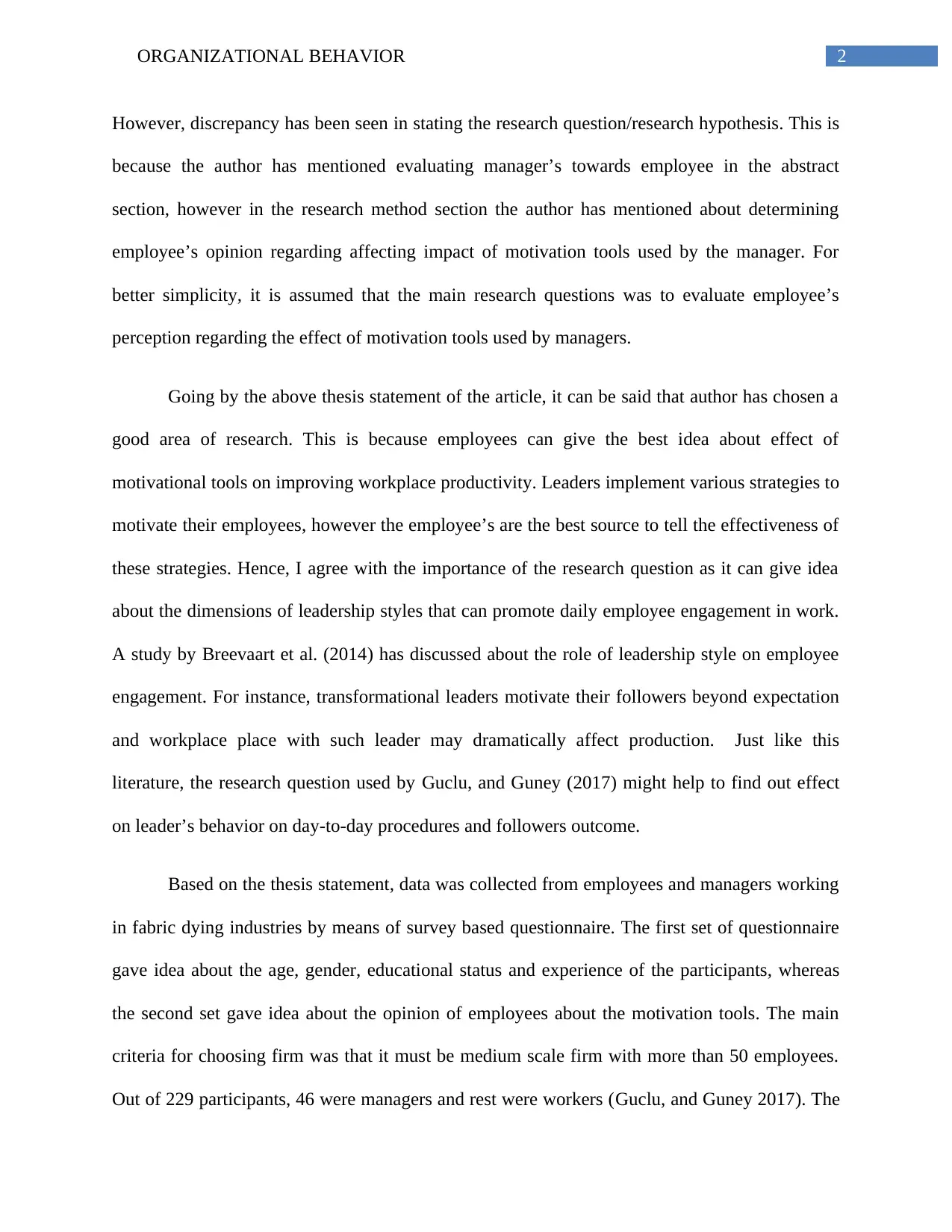
2ORGANIZATIONAL BEHAVIOR
However, discrepancy has been seen in stating the research question/research hypothesis. This is
because the author has mentioned evaluating manager’s towards employee in the abstract
section, however in the research method section the author has mentioned about determining
employee’s opinion regarding affecting impact of motivation tools used by the manager. For
better simplicity, it is assumed that the main research questions was to evaluate employee’s
perception regarding the effect of motivation tools used by managers.
Going by the above thesis statement of the article, it can be said that author has chosen a
good area of research. This is because employees can give the best idea about effect of
motivational tools on improving workplace productivity. Leaders implement various strategies to
motivate their employees, however the employee’s are the best source to tell the effectiveness of
these strategies. Hence, I agree with the importance of the research question as it can give idea
about the dimensions of leadership styles that can promote daily employee engagement in work.
A study by Breevaart et al. (2014) has discussed about the role of leadership style on employee
engagement. For instance, transformational leaders motivate their followers beyond expectation
and workplace place with such leader may dramatically affect production. Just like this
literature, the research question used by Guclu, and Guney (2017) might help to find out effect
on leader’s behavior on day-to-day procedures and followers outcome.
Based on the thesis statement, data was collected from employees and managers working
in fabric dying industries by means of survey based questionnaire. The first set of questionnaire
gave idea about the age, gender, educational status and experience of the participants, whereas
the second set gave idea about the opinion of employees about the motivation tools. The main
criteria for choosing firm was that it must be medium scale firm with more than 50 employees.
Out of 229 participants, 46 were managers and rest were workers (Guclu, and Guney 2017). The
However, discrepancy has been seen in stating the research question/research hypothesis. This is
because the author has mentioned evaluating manager’s towards employee in the abstract
section, however in the research method section the author has mentioned about determining
employee’s opinion regarding affecting impact of motivation tools used by the manager. For
better simplicity, it is assumed that the main research questions was to evaluate employee’s
perception regarding the effect of motivation tools used by managers.
Going by the above thesis statement of the article, it can be said that author has chosen a
good area of research. This is because employees can give the best idea about effect of
motivational tools on improving workplace productivity. Leaders implement various strategies to
motivate their employees, however the employee’s are the best source to tell the effectiveness of
these strategies. Hence, I agree with the importance of the research question as it can give idea
about the dimensions of leadership styles that can promote daily employee engagement in work.
A study by Breevaart et al. (2014) has discussed about the role of leadership style on employee
engagement. For instance, transformational leaders motivate their followers beyond expectation
and workplace place with such leader may dramatically affect production. Just like this
literature, the research question used by Guclu, and Guney (2017) might help to find out effect
on leader’s behavior on day-to-day procedures and followers outcome.
Based on the thesis statement, data was collected from employees and managers working
in fabric dying industries by means of survey based questionnaire. The first set of questionnaire
gave idea about the age, gender, educational status and experience of the participants, whereas
the second set gave idea about the opinion of employees about the motivation tools. The main
criteria for choosing firm was that it must be medium scale firm with more than 50 employees.
Out of 229 participants, 46 were managers and rest were workers (Guclu, and Guney 2017). The
⊘ This is a preview!⊘
Do you want full access?
Subscribe today to unlock all pages.

Trusted by 1+ million students worldwide
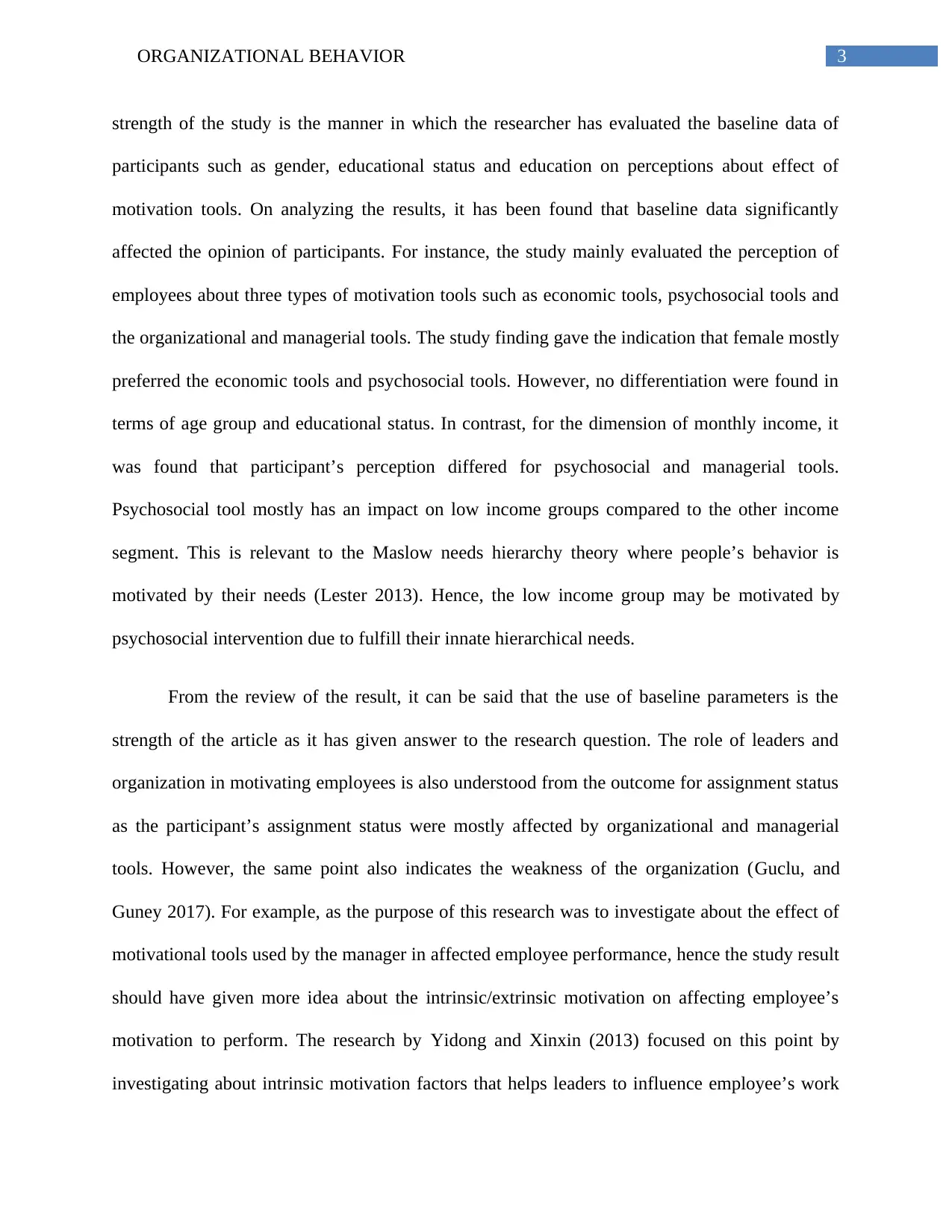
3ORGANIZATIONAL BEHAVIOR
strength of the study is the manner in which the researcher has evaluated the baseline data of
participants such as gender, educational status and education on perceptions about effect of
motivation tools. On analyzing the results, it has been found that baseline data significantly
affected the opinion of participants. For instance, the study mainly evaluated the perception of
employees about three types of motivation tools such as economic tools, psychosocial tools and
the organizational and managerial tools. The study finding gave the indication that female mostly
preferred the economic tools and psychosocial tools. However, no differentiation were found in
terms of age group and educational status. In contrast, for the dimension of monthly income, it
was found that participant’s perception differed for psychosocial and managerial tools.
Psychosocial tool mostly has an impact on low income groups compared to the other income
segment. This is relevant to the Maslow needs hierarchy theory where people’s behavior is
motivated by their needs (Lester 2013). Hence, the low income group may be motivated by
psychosocial intervention due to fulfill their innate hierarchical needs.
From the review of the result, it can be said that the use of baseline parameters is the
strength of the article as it has given answer to the research question. The role of leaders and
organization in motivating employees is also understood from the outcome for assignment status
as the participant’s assignment status were mostly affected by organizational and managerial
tools. However, the same point also indicates the weakness of the organization (Guclu, and
Guney 2017). For example, as the purpose of this research was to investigate about the effect of
motivational tools used by the manager in affected employee performance, hence the study result
should have given more idea about the intrinsic/extrinsic motivation on affecting employee’s
motivation to perform. The research by Yidong and Xinxin (2013) focused on this point by
investigating about intrinsic motivation factors that helps leaders to influence employee’s work
strength of the study is the manner in which the researcher has evaluated the baseline data of
participants such as gender, educational status and education on perceptions about effect of
motivation tools. On analyzing the results, it has been found that baseline data significantly
affected the opinion of participants. For instance, the study mainly evaluated the perception of
employees about three types of motivation tools such as economic tools, psychosocial tools and
the organizational and managerial tools. The study finding gave the indication that female mostly
preferred the economic tools and psychosocial tools. However, no differentiation were found in
terms of age group and educational status. In contrast, for the dimension of monthly income, it
was found that participant’s perception differed for psychosocial and managerial tools.
Psychosocial tool mostly has an impact on low income groups compared to the other income
segment. This is relevant to the Maslow needs hierarchy theory where people’s behavior is
motivated by their needs (Lester 2013). Hence, the low income group may be motivated by
psychosocial intervention due to fulfill their innate hierarchical needs.
From the review of the result, it can be said that the use of baseline parameters is the
strength of the article as it has given answer to the research question. The role of leaders and
organization in motivating employees is also understood from the outcome for assignment status
as the participant’s assignment status were mostly affected by organizational and managerial
tools. However, the same point also indicates the weakness of the organization (Guclu, and
Guney 2017). For example, as the purpose of this research was to investigate about the effect of
motivational tools used by the manager in affected employee performance, hence the study result
should have given more idea about the intrinsic/extrinsic motivation on affecting employee’s
motivation to perform. The research by Yidong and Xinxin (2013) focused on this point by
investigating about intrinsic motivation factors that helps leaders to influence employee’s work
Paraphrase This Document
Need a fresh take? Get an instant paraphrase of this document with our AI Paraphraser
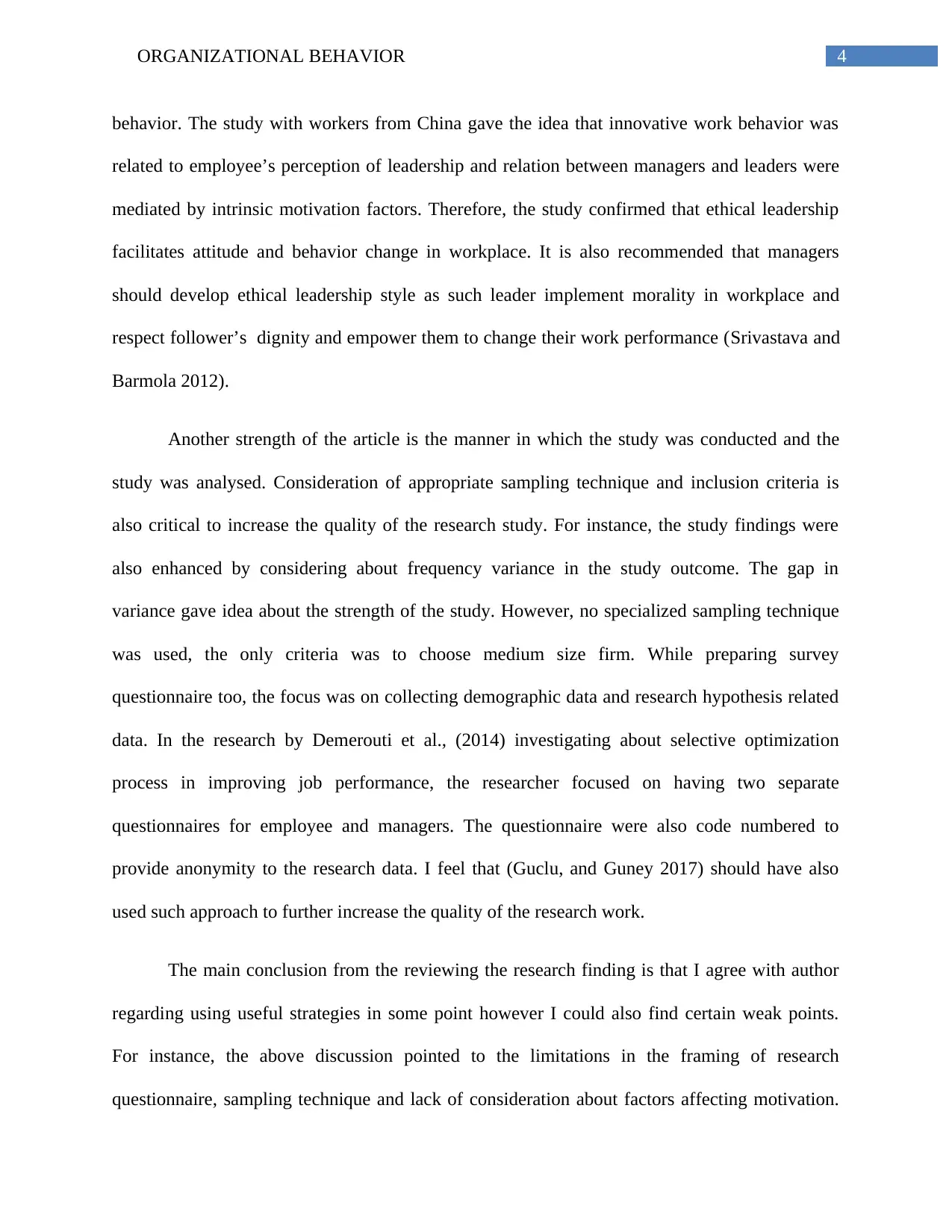
4ORGANIZATIONAL BEHAVIOR
behavior. The study with workers from China gave the idea that innovative work behavior was
related to employee’s perception of leadership and relation between managers and leaders were
mediated by intrinsic motivation factors. Therefore, the study confirmed that ethical leadership
facilitates attitude and behavior change in workplace. It is also recommended that managers
should develop ethical leadership style as such leader implement morality in workplace and
respect follower’s dignity and empower them to change their work performance (Srivastava and
Barmola 2012).
Another strength of the article is the manner in which the study was conducted and the
study was analysed. Consideration of appropriate sampling technique and inclusion criteria is
also critical to increase the quality of the research study. For instance, the study findings were
also enhanced by considering about frequency variance in the study outcome. The gap in
variance gave idea about the strength of the study. However, no specialized sampling technique
was used, the only criteria was to choose medium size firm. While preparing survey
questionnaire too, the focus was on collecting demographic data and research hypothesis related
data. In the research by Demerouti et al., (2014) investigating about selective optimization
process in improving job performance, the researcher focused on having two separate
questionnaires for employee and managers. The questionnaire were also code numbered to
provide anonymity to the research data. I feel that (Guclu, and Guney 2017) should have also
used such approach to further increase the quality of the research work.
The main conclusion from the reviewing the research finding is that I agree with author
regarding using useful strategies in some point however I could also find certain weak points.
For instance, the above discussion pointed to the limitations in the framing of research
questionnaire, sampling technique and lack of consideration about factors affecting motivation.
behavior. The study with workers from China gave the idea that innovative work behavior was
related to employee’s perception of leadership and relation between managers and leaders were
mediated by intrinsic motivation factors. Therefore, the study confirmed that ethical leadership
facilitates attitude and behavior change in workplace. It is also recommended that managers
should develop ethical leadership style as such leader implement morality in workplace and
respect follower’s dignity and empower them to change their work performance (Srivastava and
Barmola 2012).
Another strength of the article is the manner in which the study was conducted and the
study was analysed. Consideration of appropriate sampling technique and inclusion criteria is
also critical to increase the quality of the research study. For instance, the study findings were
also enhanced by considering about frequency variance in the study outcome. The gap in
variance gave idea about the strength of the study. However, no specialized sampling technique
was used, the only criteria was to choose medium size firm. While preparing survey
questionnaire too, the focus was on collecting demographic data and research hypothesis related
data. In the research by Demerouti et al., (2014) investigating about selective optimization
process in improving job performance, the researcher focused on having two separate
questionnaires for employee and managers. The questionnaire were also code numbered to
provide anonymity to the research data. I feel that (Guclu, and Guney 2017) should have also
used such approach to further increase the quality of the research work.
The main conclusion from the reviewing the research finding is that I agree with author
regarding using useful strategies in some point however I could also find certain weak points.
For instance, the above discussion pointed to the limitations in the framing of research
questionnaire, sampling technique and lack of consideration about factors affecting motivation.
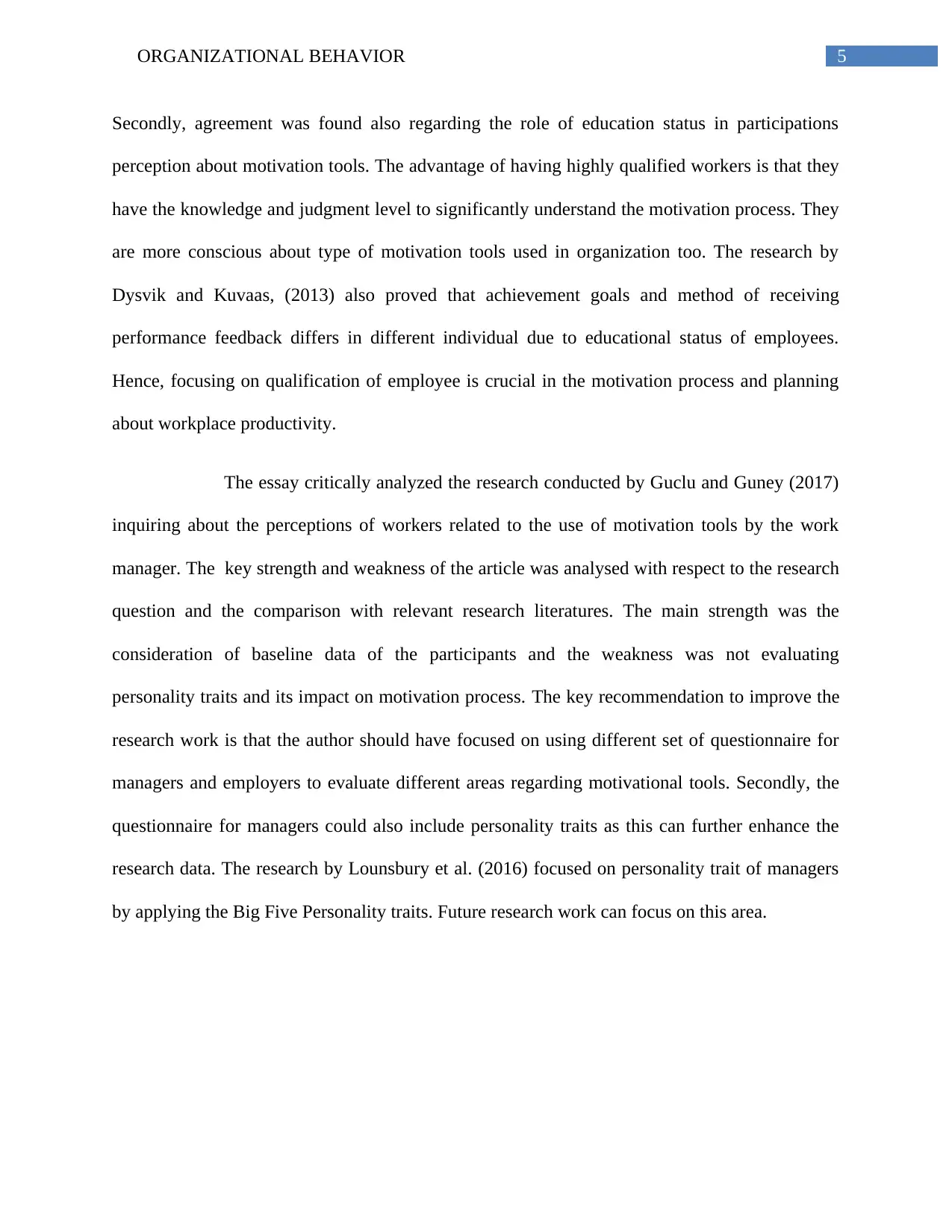
5ORGANIZATIONAL BEHAVIOR
Secondly, agreement was found also regarding the role of education status in participations
perception about motivation tools. The advantage of having highly qualified workers is that they
have the knowledge and judgment level to significantly understand the motivation process. They
are more conscious about type of motivation tools used in organization too. The research by
Dysvik and Kuvaas, (2013) also proved that achievement goals and method of receiving
performance feedback differs in different individual due to educational status of employees.
Hence, focusing on qualification of employee is crucial in the motivation process and planning
about workplace productivity.
The essay critically analyzed the research conducted by Guclu and Guney (2017)
inquiring about the perceptions of workers related to the use of motivation tools by the work
manager. The key strength and weakness of the article was analysed with respect to the research
question and the comparison with relevant research literatures. The main strength was the
consideration of baseline data of the participants and the weakness was not evaluating
personality traits and its impact on motivation process. The key recommendation to improve the
research work is that the author should have focused on using different set of questionnaire for
managers and employers to evaluate different areas regarding motivational tools. Secondly, the
questionnaire for managers could also include personality traits as this can further enhance the
research data. The research by Lounsbury et al. (2016) focused on personality trait of managers
by applying the Big Five Personality traits. Future research work can focus on this area.
Secondly, agreement was found also regarding the role of education status in participations
perception about motivation tools. The advantage of having highly qualified workers is that they
have the knowledge and judgment level to significantly understand the motivation process. They
are more conscious about type of motivation tools used in organization too. The research by
Dysvik and Kuvaas, (2013) also proved that achievement goals and method of receiving
performance feedback differs in different individual due to educational status of employees.
Hence, focusing on qualification of employee is crucial in the motivation process and planning
about workplace productivity.
The essay critically analyzed the research conducted by Guclu and Guney (2017)
inquiring about the perceptions of workers related to the use of motivation tools by the work
manager. The key strength and weakness of the article was analysed with respect to the research
question and the comparison with relevant research literatures. The main strength was the
consideration of baseline data of the participants and the weakness was not evaluating
personality traits and its impact on motivation process. The key recommendation to improve the
research work is that the author should have focused on using different set of questionnaire for
managers and employers to evaluate different areas regarding motivational tools. Secondly, the
questionnaire for managers could also include personality traits as this can further enhance the
research data. The research by Lounsbury et al. (2016) focused on personality trait of managers
by applying the Big Five Personality traits. Future research work can focus on this area.
⊘ This is a preview!⊘
Do you want full access?
Subscribe today to unlock all pages.

Trusted by 1+ million students worldwide
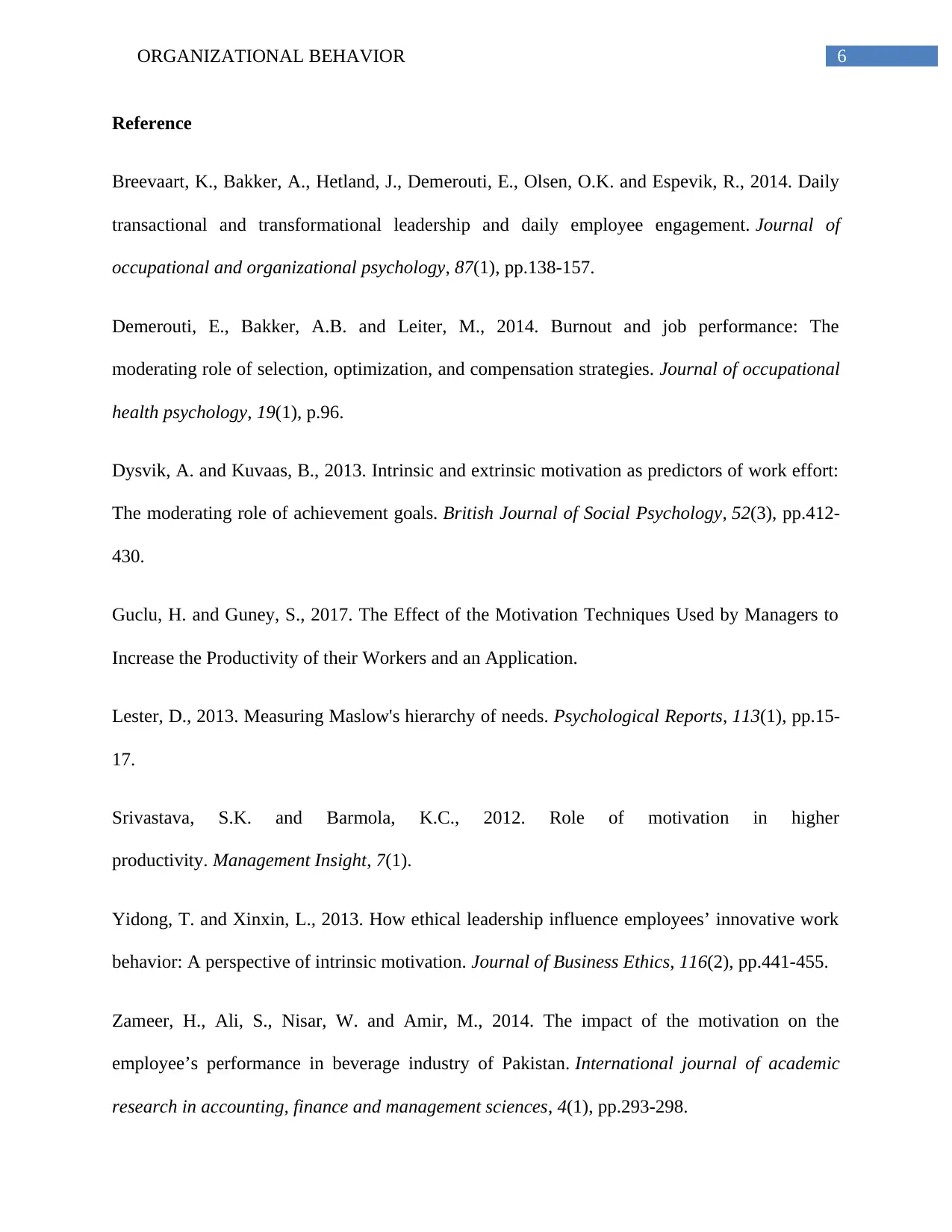
6ORGANIZATIONAL BEHAVIOR
Reference
Breevaart, K., Bakker, A., Hetland, J., Demerouti, E., Olsen, O.K. and Espevik, R., 2014. Daily
transactional and transformational leadership and daily employee engagement. Journal of
occupational and organizational psychology, 87(1), pp.138-157.
Demerouti, E., Bakker, A.B. and Leiter, M., 2014. Burnout and job performance: The
moderating role of selection, optimization, and compensation strategies. Journal of occupational
health psychology, 19(1), p.96.
Dysvik, A. and Kuvaas, B., 2013. Intrinsic and extrinsic motivation as predictors of work effort:
The moderating role of achievement goals. British Journal of Social Psychology, 52(3), pp.412-
430.
Guclu, H. and Guney, S., 2017. The Effect of the Motivation Techniques Used by Managers to
Increase the Productivity of their Workers and an Application.
Lester, D., 2013. Measuring Maslow's hierarchy of needs. Psychological Reports, 113(1), pp.15-
17.
Srivastava, S.K. and Barmola, K.C., 2012. Role of motivation in higher
productivity. Management Insight, 7(1).
Yidong, T. and Xinxin, L., 2013. How ethical leadership influence employees’ innovative work
behavior: A perspective of intrinsic motivation. Journal of Business Ethics, 116(2), pp.441-455.
Zameer, H., Ali, S., Nisar, W. and Amir, M., 2014. The impact of the motivation on the
employee’s performance in beverage industry of Pakistan. International journal of academic
research in accounting, finance and management sciences, 4(1), pp.293-298.
Reference
Breevaart, K., Bakker, A., Hetland, J., Demerouti, E., Olsen, O.K. and Espevik, R., 2014. Daily
transactional and transformational leadership and daily employee engagement. Journal of
occupational and organizational psychology, 87(1), pp.138-157.
Demerouti, E., Bakker, A.B. and Leiter, M., 2014. Burnout and job performance: The
moderating role of selection, optimization, and compensation strategies. Journal of occupational
health psychology, 19(1), p.96.
Dysvik, A. and Kuvaas, B., 2013. Intrinsic and extrinsic motivation as predictors of work effort:
The moderating role of achievement goals. British Journal of Social Psychology, 52(3), pp.412-
430.
Guclu, H. and Guney, S., 2017. The Effect of the Motivation Techniques Used by Managers to
Increase the Productivity of their Workers and an Application.
Lester, D., 2013. Measuring Maslow's hierarchy of needs. Psychological Reports, 113(1), pp.15-
17.
Srivastava, S.K. and Barmola, K.C., 2012. Role of motivation in higher
productivity. Management Insight, 7(1).
Yidong, T. and Xinxin, L., 2013. How ethical leadership influence employees’ innovative work
behavior: A perspective of intrinsic motivation. Journal of Business Ethics, 116(2), pp.441-455.
Zameer, H., Ali, S., Nisar, W. and Amir, M., 2014. The impact of the motivation on the
employee’s performance in beverage industry of Pakistan. International journal of academic
research in accounting, finance and management sciences, 4(1), pp.293-298.
Paraphrase This Document
Need a fresh take? Get an instant paraphrase of this document with our AI Paraphraser
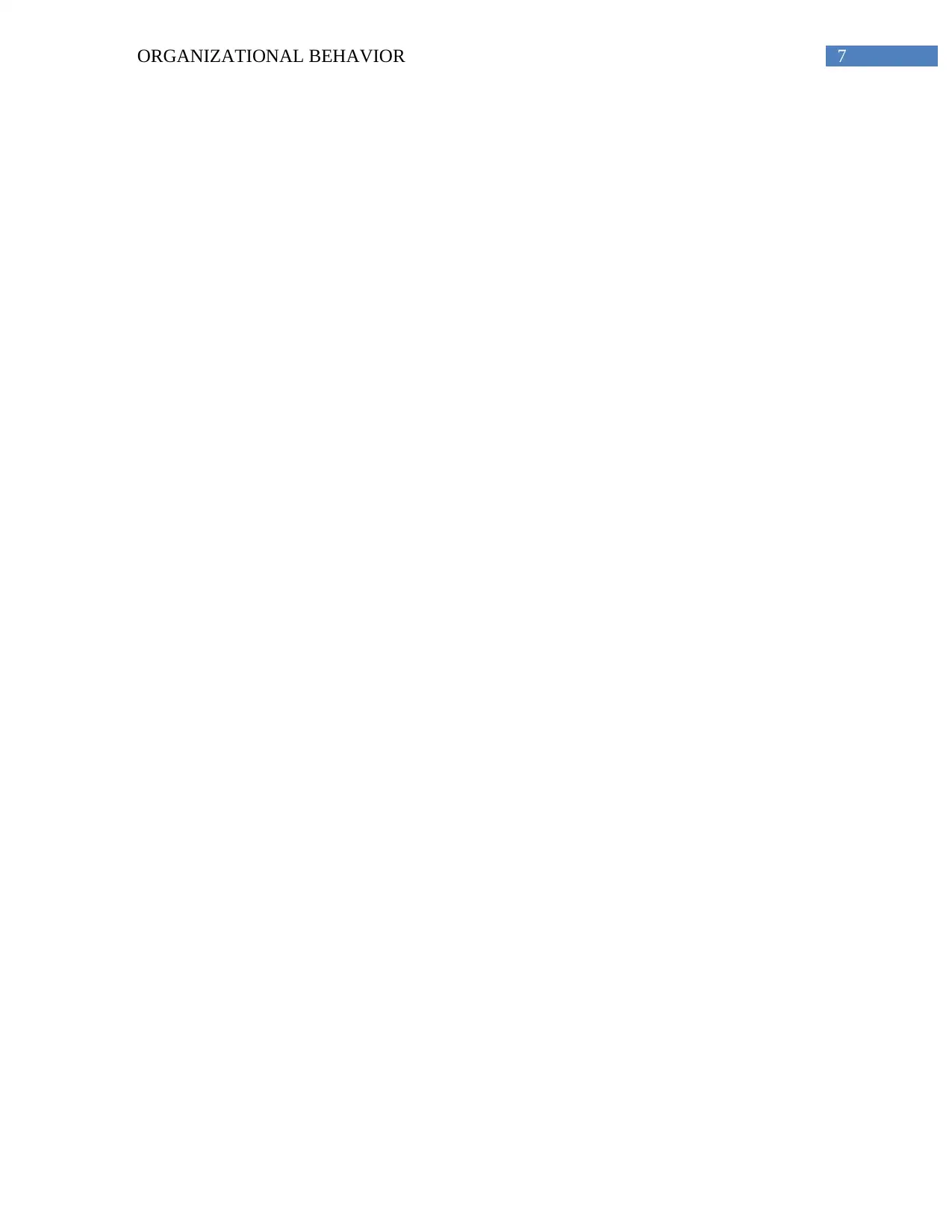
7ORGANIZATIONAL BEHAVIOR
1 out of 8
Related Documents
Your All-in-One AI-Powered Toolkit for Academic Success.
+13062052269
info@desklib.com
Available 24*7 on WhatsApp / Email
![[object Object]](/_next/static/media/star-bottom.7253800d.svg)
Unlock your academic potential
Copyright © 2020–2025 A2Z Services. All Rights Reserved. Developed and managed by ZUCOL.





